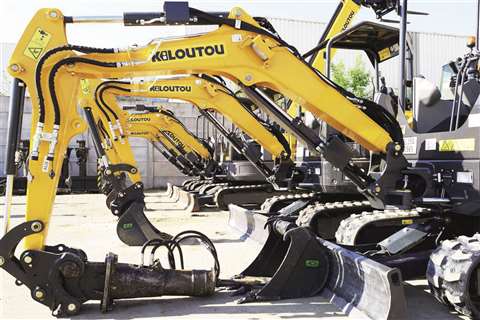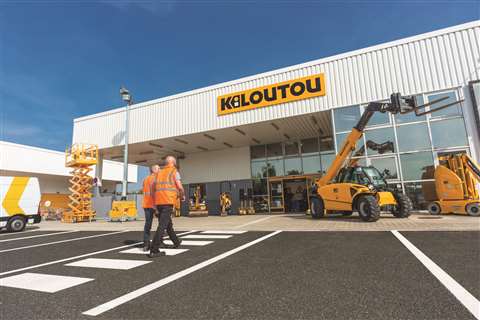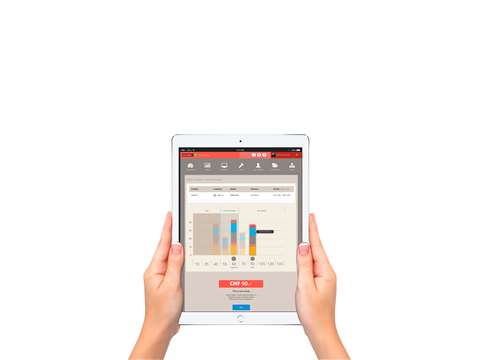How dynamic pricing is being used in equipment rental
20 December 2022
Dynamic pricing for equipment rental is used to match supply and demand to optimise revenues among other benefits. Belinda Smart spoke to industry experts about their strategies.
Anyone who has booked a holiday or a flight during the school holidays and witnessed prices skyrocket in line with demand will have experienced dynamic pricing, an approach – typically enabled by technology – that matches and analyses supply and demand, with prices offered varying accordingly.
 Photo: Reuters - Ekkasit Keatsirikul - Alamy
Photo: Reuters - Ekkasit Keatsirikul - Alamy
Its use is now established in the rental sector, with North American giant United Rentals among early adopters.
What are the advantages of dynamic pricing?
Switzerland-headquartered Avesco Rent introduced its dynamic pricing strategy in 2014. In fact, as CEO Vincent Albasini tells IRN, the company created a separate business - Fast Rent, to test different models of yield management, and customers’ reactions and spending habits.
From 2016, it gradually integrated the pricing strategy – having studied its execution in the aviation, hotel, and car industries – throughout its business.
“Pricing strategy is an important competitive advantage; in summary our organisation allows us to cross check suggestions given by the IT algorithm with feedback from our teams in order to propose the most accurate price.”
Albasini says dynamic pricing has directly impacted the company’s ability to optimise not just its rates but also machine occupancy levels.
For example, “After the official construction vacations in Switzerland (August), we noticed a drop in our occupancy rate in the 5-10T wheel excavators. After analysis and consultation, we quickly made adjustments in order to increase the time utilisation.”
And it’s playing a part in today’s climate, amid the supply chain crisis and other pressures such as price inflation.
“We have succeeded for the first time in a long time in raising the price level of all products. Although this situation remains fragile, it has been possible thanks to the agility of our organisation and the strategic approach of yield management.”
“To do this, we need ongoing collection of market data, experts who analyse and simulate different versions while remaining as close as possible to the field. There is no exact science or 100% automatic way that allows a system to work. It is a set of compilation and adjustments.”
Investment in software is crucial for managing data, running scenarios, and proposing pricing alternatives, he says.
“For some product lines, it will directly impact the online pricing algorithm and in other cases, it will act as a kind of digital advisor for pricing management cell.”
What is the right approach to dynamic pricing?
Albasani also points out that dynamic pricing isn’t necessarily a catch-all solution for all areas of rental. “The dynamic pricing approach for product segments that are highly competitive, simple, with short rental periods, in mature markets, surely offers good margin.
“For high value-added products and solutions, the impact of price will remain marginal.”
His advice to any business starting to engage with dynamic pricing is to “take the time to structure the correct approach, study your environment and your competitors and don’t underestimate the internal resistance of your organisation to implement your pricing strategy.”
Pierre Knoche, France Managing Director for France headquartered Kiloutou, tells IRN dynamic pricing is now a key element of the company’s strategy.
“Historically, Kiloutou’s employees in our branches were adapting prices according to simple supply and demand principles.
“Local branches were therefore defining price levels depending on the number of machines available versus perceived demand and specific guidelines from the local management.”
Revenue optimisation for equipment rental
The company has since adopted a more considered approach, and its official dynamic pricing project was launched in 2019.
Knoche says the initiative was triggered by the need for revenue optimisation along with the fact that the company’s historical approach was resulting in significant price volatility for the same equipment - depending on the client, the area, the period of the year.
 Kiloutou is now in the process of implementing dynamic pricing for its commercial vehicles fleet. (Photo: Kiloutou)
Kiloutou is now in the process of implementing dynamic pricing for its commercial vehicles fleet. (Photo: Kiloutou)
“The main principles were to define centrally the rules for price definition and monitor price level variations.”
Dynamic pricing was first launched on a limited number of Kiloutou machines, while calculations and recommendations were implemented manually.
“Successive evolutions then allowed to roll out automated mechanisms, to enlarge the coverage of our fleet and to monitor the value created.”
“Based on historical data, we built price ranges - minimum and maximum prices - for each item of equipment and area, which could be easily reviewed over time.
“As with any dynamic pricing system, it then relies on two components: the offer – or supply – in other words, the number of machines available, and the demand, which can be combined into an occupancy rate.
“This ratio is monitored daily at the machine level and compared to our predictive models, based on actual bookings and historical trends,” he says.
“The combination of occupancy rate and price range defined provides our employees with the final price.”
Knoche says SaaS software from Pricemoov supports the company’s dynamic pricing.
“It stores all the historical data used to conduct analysis and build the price ranges; it receives all the actual occupation rates from our ERP and forecasts the occupation rate to be expected in the near future at the area and equipment level.
“Finally, it returns recommended prices in real time to our employees in the branches in order to provide our clients with reliable quotes and close deals. In parallel, prices are also automatically updated on our website.”
How to implement a dynamic pricing strategy
Kiloutou – whose fleet includes earthmoving equipment, powered access equipment, commercial vehicles, tools, power supply equipment and modular construction - is now in the process of implementing dynamic pricing for its commercial vehicles fleet.
“This is one of the last scopes untackled so far by our system as it requires us to include an additional parameter in the pricing model: the mileage/day - which is not relevant for other classes of equipment.
Knoche says keeping the dynamic pricing strategy simple is critical; there’s a risk in being weighed down by complexity.
“First make it simple. Dynamic pricing is a complex matter which requires a lot of back and forth and relies on historical data analysis and tests.
“Pursuing full customisation could easily lead to excessive complexity and turn into a nightmare as numerous constraints have to be taken into account: number of equipment types, price consistency between similar machines, multiple rental durations, various business objectives among areas, and so on.”
“It’s also important to measure the added value of the first initiatives before enlarging the approach. And finally, the most important: make sure you have a pricing back-up system to be able to restore in a few seconds your ‘manual’ pricing system!”
Going forward, Knoche sees dynamic pricing uptake extending beyond the major rental players.
“Today, regional rental companies are beginning to work on these topics, and it is very likely that they will catch up with large players, using SaaS software and leveraging industry’s experience gained.
With all the talk of green transition – it’s worth wondering a potential role for dynamic pricing.
“Sustainability and cost efficiency are not directly related to the dynamic pricing approach. However, carbon pricing may become an additional parameter taken into account in our models in coming years.”
Pricing software
Rental software suppliers offering tools for dynamic pricing, include Wynne Systems, one of the key players in this space.
It first created dynamic pricing solutions in 2012 through multiple third-party pricing engines and by 2016 Wynne was a sup
 Kiloutou is in the process of implementing dynamic pricing for its commercial vehicles fleet. (Photo: Kiloutou)
Kiloutou is in the process of implementing dynamic pricing for its commercial vehicles fleet. (Photo: Kiloutou)
plier of Rental Management Software with three-tier pricing with optional rates including: optimal rates, book rates, and floor rates
VP of Product and IT, Patrick Stephens, tells IRN the Wynne platform incorporates table upload and web services connected to several pricing providers, allowing customers to offer a near real-time range of rates and tiered pricing.
And it also provides an upload option for customers who prefer not to use third-party pricing engines.
“Pricing provider integrations enable customers to see a variety of factors, such as customer history, current time utilisation of equipment, and regional pricing averages for specific equipment classes to be considered in delivering the optimal rate to a customer.
“Optimal, book, and floor rates are shown directly on the screen for the user. Our customers use dynamic pricing to optimise their rates across all classes of equipment they are interested in.
“They can change daily or multiple times per day based on competitor price movements and market trends. Since the feature has been in our product for over a decade, specific case studies are unavailable.”
Demand for affordable equipment
“Like many industries around the globe, rental companies are struggling with doing more with what they have,” Stephens tells IRN.
“The pandemic and other factors have led to global supply chain disruptions that directly affect timely and affordable access to equipment.
“Labour shortages make it difficult to meet demand and impact the ability to rent equipment. Rising fuel prices, as well as uncertain global events, are also significant challenges to remaining on budget and time.
 The Avesco Rent pricing tool. (Photo: Avesco)
The Avesco Rent pricing tool. (Photo: Avesco)
“These trends are forcing our customers and prospects to reassess their daily operations.
“A crucial component to doing more with what you have is the ability to provide dynamic pricing. Wynne Systems provides the technology and data to help our customers make better decisions and ultimately win more deals.
“Dynamic pricing provides excellent guidance for the inside and outside sales teams and allows businesses to increase their ROR by keeping current with market conditions.
“The goal is to optimise margins and increase the chances of a sale. Deploying a system that can enable reset price targets, as the product level, based on facts, improves profit and sales.
Dynamic pricing with Wynne Systems’ Enterprise Resource Planning (ERP) also offers the analytics and intelligence to improve utilisation, manage inventory, analyse margins, and reduce costs.
“For anyone considering dynamic pricing, it is essential to consider if the historical data is clean, if competitive information is available, and to validate that the recommendations are based on actual data and not on theory only.”




